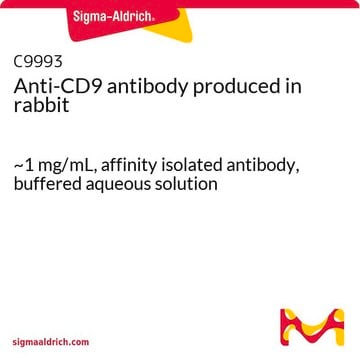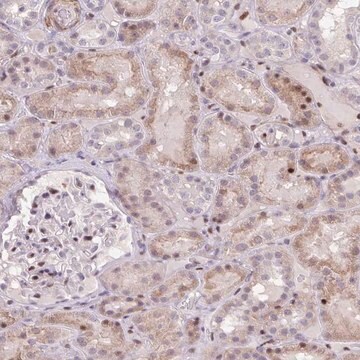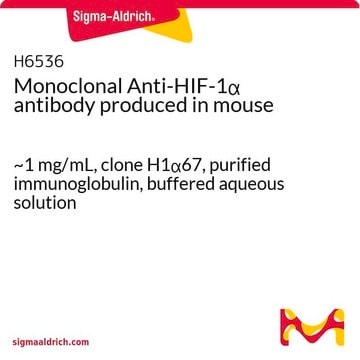一般說明
We are committed to bringing you greener alternative products, which adhere to one or more of The 12 Principles of Green Chemistry.This antibody is Preservative-free, produced without the harm or sacrifice of animals and exceptionally stable to allow for ambient shipping and storage if needed and thus aligns with "Waste Prevention", "Designing Safer Chemicals" and "Design for Energy Efficiency".
Click here for more information.
ZooMAb® antibodies represent an entirely new generation of recombinant monoclonal antibodies.Each ZooMAb® antibody is manufactured using our proprietary recombinant expression system, purified to homogeneity, and precisely dispensed to produce robust and highly reproducible lot-to-lot consistency. Only top-performing clones are released for use by researchers. Each antibody is validated for high specificity and affinity across multiple applications, including its most commonly used application. ZooMAb® antibodies are reliably available and ready to ship when you need them.
特異性
Clone 5I17 is a ZooMAb® Rabbit recombinant monoclonal antibody that specifically detects Annexin A1. It targets an epitope within 14 amino acids from the C-terminal region.
免疫原
KLH-conjugated linear peptide corresponding to 14 amino acids from the C-terminal region of human Annexin A1.
應用
Quality Control Testing
Evaluated by Western Blotting in COS-7 cell lysate.
Western Blotting Analysis: A 1:1,000 dilution of this antibody detected Annexin A1 in COS-7 cell lysate.
Tested applications
Western Blotting Analysis: A 1:1,000 dilution from a representative lot detected Annexin A1 in lysates from Human Lung tissue and NIH3T3 cells.
Immunocytochemistry Analysis: A 1:100 dilution from a representative lot detected Annexin A1 in C2C12 cells.
Immunohistochemistry (Paraffin) Analysis: A 1:1,000 dilution from a representative lot detected Annexin A1 in human esophagus tissue sections.
Affinity Binding Assay: A representative lot of this antibody bound Annexin A1 peptide with a KD of 1.2 x 10-7 in an affinity binding assay.
Note: Actual optimal working dilutions must be determined by end user as specimens, and experimental conditions may vary with the end user
標靶描述
Annexin A1 (UniProt: P04083; also known as Annexin I, Annexin-1, Calpactin II, Calpactin-2, Chromobindin-9, Lipocortin I, Phospholipase A2 inhibitory protein, p35) is encoded by the ANXA1 (also known as ANX1, LPC1) gene (Gene ID: 301) in human. Annexin A1 is a non-covalently linked, widely expressed, homodimeric, calcium and phospholipid binding protein that displays calcium-dependent binding to phospholipid membranes and can promote membrane aggregation in vitro. It displays high affinity for Ca2+ and can bind up to eight Ca2+ ions. It is present intracellularly and at the membrane, but can also be secreted into the circulation where it can signal in both an autocrine and paracrine manner. It is secreted, in part, via exosomes and other secretory vesicles and its secretion is increased in response to wounds and inflammation and upon T-cell activation. Annexin A1 is reported to contribute to the adaptive immune response by enhancing signal transduction cascades that are triggered by T-cell activation and is known to regulate differentiation and proliferation of activated T-cells. It is actively involved in the phagocytosis of apoptotic leukocytes and promotes resolution of inflammation and wound healing. It also plays important role in the innate immune response as effector of glucocorticoid-mediated responses and regulator of the inflammatory process. It is shown to down-regulate early phase of the inflammatory response. Annexin A1 functions at least in part by activating the formyl peptide receptors and downstream signal transduction cascades. This ZooMAbZooMAb® recombinant monoclonal antibody, generated by our propriety technology, offers significantly enhanced specificity, affinity, reproducibility, and stability over conventional monoclonals. (Ref.: Purvis, GSD., et al. (2019). Front. Immunol. 10: 938; Leoni, G., et al. (2015). J. Clin. Invest. 125(3); 1215-1227; D Acquisto, F., et al. (2007). Blood. 109(3); 1095-1102).
外觀
Purified recombinant rabbit monoclonal antibody IgG, lyophilized in PBS, 5% Trehalose, normal appearance a coarse or translucent resin. The PBS/trehalose components in the ZooMAb formulation can have the appearance of a semi-solid (bead like gel) after lyophilization. This is a normal phenomenon. Please follow the recommended reconstitution procedure in the data sheet to dissolve the semi-solid, bead-like, gel-appearing material. The resulting antibody solution is completely stable and functional as proven by full functional testing. Contains no biocide or preservatives, such as azide, or any animal by-products. Larger pack sizes provided as multiples of 25 μL.
重構
300 μg/mL after reconstitution at 25 μL per vial. Please refer to guidance on suggested starting dilutions and/or titers per application and sample type.
儲存和穩定性
Recommend storage of lyophilized product at 2-8°C; Before reconstitution, micro-centrifuge vials briefly to spin down material to bottom of the vial; Reconstitute each vial by adding 25 μL of filtered lab grade water or PBS; Reconstituted antibodies can be stored at 2-8°C, or -20°C for long term storage. Avoid repeated freeze-thaws.
法律資訊
ZooMAb is a registered trademark of Merck KGaA, Darmstadt, Germany
免責聲明
Unless otherwise stated in our catalog or other company documentation accompanying the product(s), our products are intended for research use only and are not to be used for any other purpose, which includes but is not limited to, unauthorized commercial uses, in vitro diagnostic uses, ex vivo or in vivo therapeutic uses or any type of consumption or application to humans or animals.









